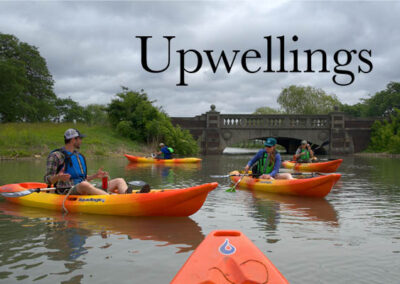Environment, public attitudes, and decision-making all play important role

The research team developed a novel technique for mapping onshore and offshore changes using a jet ski to rapidly measure changes in the underwater portion of the beach in response to severe storms and water level changes. Photo: Guy Meadows
Along Lake Michigan’s 1,640 miles of coastline, record-high water levels and severe storm surges are causing significant erosion to beaches and bluffs and are damaging infrastructure. Developing sustainable protection measures and policies requires an understanding of the physical, biological, and social factors of the shoreline, especially as climate change alters weather patterns.
A coordinated and diverse regional research team, including investigators from universities in Michigan, Wisconsin, and Indiana, are taking a comprehensive look at all of Lake Michigan’s shorelines. They are hoping the results of their research will help develop resilient coastal communities around all of Lake Michigan. They are tracking the movement of sediment along the shoreline, assessing attitudes about lakeside development and protection, and developing a framework to help improve decision-making around coastal resources and shoreline management.
“Never before have scientists and engineers taken a holistic view and combined resources and expertise to study the cumulative impacts of shoreline management decisions,” said Guy Meadows, professor and founding director at the Great Lakes Research Center at Michigan Technological University.
Jointly funded by Michigan Sea Grant (MISG), Illinois-Indiana Sea Grant, and Wisconsin Sea Grant, this project will work to meet the needs of the many private landowners, communities, and public officials across the four states and numerous communities found along this coastline. The project’s goal is particularly challenging as environmental conditions and climate change cause rapid changes along the coast.

Underwater, self-recording instruments are being used to monitor how storm-induced waves move sediment from the nearshore to deep water where it is lost from the beach forever. Photo: Guy Meadows
Michigan Team Focuses on Physical Aspects
The MISG-funded portion of the project involves tracking erosion and sediment movement along the shoreline in three locations around the lake. The team is working with municipalities and individual property owners in Concordia, WI.; Beverly Shores, IN.; and South Haven, MI. These three areas were chosen as representative of three major Lake Michigan coastal features — bluffs, dunes, and sand beaches. The lessons learned from this work will be applied to similar coastal communities to build resilience.
The Michigan team is taking field measurements of currents, waves, and sediment transport. They are also analyzing historical aerial photos to assess shoreline changes over time and to gauge the effects of shore protection measures, like seawalls and jetties. They are using several high-tech measurement devices, including an underwater bottom-mapping drone; a bottom-mapping jet ski with both depth mapping sonar and side scan sonar; and an aerial drone to map the beaches. In addition, a self-recording underwater instrument system is being deployed for about a month at a time. The instrument will monitor how storm-induced waves move sediment from the nearshore to deep water where it is lost from the beach forever. Researchers will then use Michigan Tech’s supercomputing cluster to run detailed numerical hydrodynamic models and develop numerical forecasts of how the beach we see and the underwater beach respond to both human and climate changes.
When combined, this information will provide insight into the movement of nearshore sediment and will help identify coastal areas with high erosion potential. It also will help characterize areas where sediment is trapped or diverted and develop an inventory of coastal sediment in Lake Michigan – how much sediment is coming into the lake, how much is going out, and how much is being stored. The team also is assessing the cumulative impacts of shoreline protection structures through historical aerial images and computer model scenarios of varying lake levels and storm events.
Researchers Making Steady Progress
To date, the researchers have developed a novel technique for mapping onshore and offshore changes using a “single-person” survey methodology that was tested at 14 locations in September 2020. This method captures the rapid and unprecedented changes in bluff, beach, and nearshore profiles due to record-setting high water levels and wave energies along the Lake Michigan shoreline in critical high-erosion rate areas. The approach involves using a jet ski to rapidly measure changes in the underwater portion of the beach in response to severe storms and water level changes. The technique was developed amid the COVID-19 pandemic to allow one person to conduct the work alone and without risk.
In addition, the team has completed an initial evaluation of all high-resolution aerial and satellite coastal imagery available to capture the most recent episode of high coastal erosion; an extension of this concept also was undertaken on the Indiana shoreline. The researchers also have initiated hydrodynamic modeling of wind, wave, and shoreline change for all of Lake Michigan.
The project team also includes social scientists who are focusing on the root causes of community conflict on this issue. The goals are to develop better community planning processes for shoreline protection and restoration, assess public attitudes and perceptions about different shore protection options, and examine variables that affect community relationships. The team will develop a community of practice to guide decision-making for what coastal stabilization measures to use and how to communicate those decisions with the public.
In addition to Meadows, the research team includes principal investigators Chin Wu, professor in the Civil and Environmental Engineering Department at the University of Wisconsin-Madison; and Cary Troy, an associate professor in the Lyles School of Civil Engineering at Purdue University. Michigan Sea Grant Extension Educator Mark Breederland is assisting with outreach, and Michigan Coastal Management Program and a NOAA Coastal Resilience grant are providing additional funding for this project.
Read more details about the work going on in Illinois-Indiana and Wisconsin.


